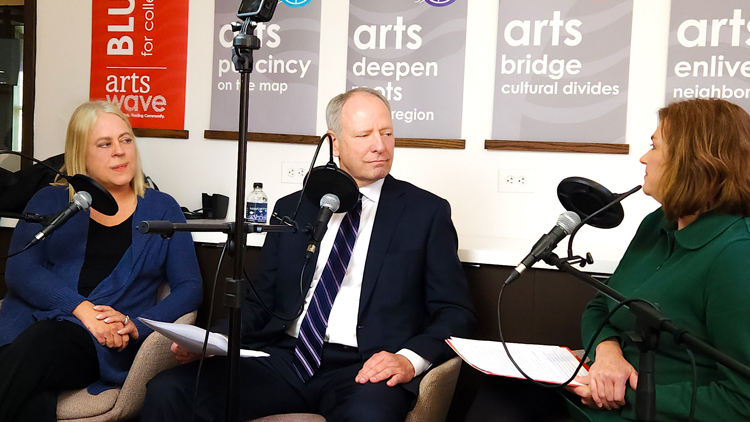posted by Alecia Kintner ON
Feb 13, 2023

(L to R) ArtsWrap guests Kim Kern and Scott Robertson with host Alecia Kintner
Hear the full discussion with Kim Kern and Scott Robertson on episode five of ArtsWrap with Alecia, available wherever you get your podcasts.
More than half the region's teachers report a reduction of arts education in their schools. Many things might be to blame, such as budget cuts, emphasis on testing, or busy schedules. Yet, a recent survey by the U.C. Center for Evaluation Services found
that 97% of Cincinnatians believe that arts education fosters creativity and positive social development in youth. And 72% of the nation's business leaders say that creativity is the top skill they are looking for when hiring, according to Americans
for the Arts. ArtsWave is focused on the disconnects between the high value that educators, parents and employers place on the arts and the inconsistent access to arts experienced by young people.
"Creating an environment where we allow young people to experience art and culture is vitally important to our economic development and growth," says 2023 ArtsWave Campaign Co-Chair Scott Robertson of RCF Group. "Every company is looking for talent, whether
you're a multinational or a mid-cap or a small business, you need great talent. And great talent very often comes from young people who come up through an arts-rich community."
While Cincinnati has an abundance of arts, access to arts education is uneven, particularly for youth in low-income households. The Children's Theatre of Cincinnati (TCT) is one of many organizations coordinating efforts with ArtsWave to ramp up and track
the number of arts education experiences available to local youth. According to CEO Kim Kern, TCT welcomes 60,000 students in classroom groups to its productions each year, filling gaps in school offerings.
On a national level, Americans for the Arts has documented the importance of the arts in education. Their research shows that young people with high arts involvement are four times more likely to be recognized for academic achievement. They also score,
on average, 100 points higher on the SAT. Arts-engaged youth, particularly in low-income households, are five times less likely to drop out of high school and twice as likely to graduate from college. There are community benefits, too. Participation
in after-school arts programs reduces juvenile crime by more than 5% in lower-income cities.
Given this evidence, ArtsWave is introducing a new partnership with Cincinnati Public Schools and organizations like the Children's Theater to systematize annual arts field trips for every elementary student, every year. "The ArtsWave Campaign's Chairmen's
Challenge is asking all donors to step up, increase their gift, make a new gift to create a system where every child in CPS can count on at least one arts field trip every year, in first through sixth grade," Robertson explained.
Arts field trips have direct ties to school curriculum. For example, fourth graders visiting the Cincinnati Art Museum are immersed in U.S. History lessons via works in the art collection, building upon classroom learning.
There are social and emotional benefits as well, said Kern. "I think today, in a very different world than it was 20 years ago, with pandemics and cyber bullying and school violence and civil unrest, it is more important than ever that children are exposed
to imagination and inspiration and seeing those positive messages of inclusion and acceptance that you see on our stage and many other arts organizations. It's more critical than ever. It's not just a field trip, it's an inspiration, and a chance
for children to see the future in a more positive light than the present they might be living it now."
ArtsWave believes that the powerful potential to illuminate a better future for our youth is worth increased investment.
ArtsWave is the engine for Cincy’s arts. To help make thousands of concerts, shows, exhibitions and experiences happen, give at artswave.org/give. Listen to this full podcast episode at artswave.org/artswrap.